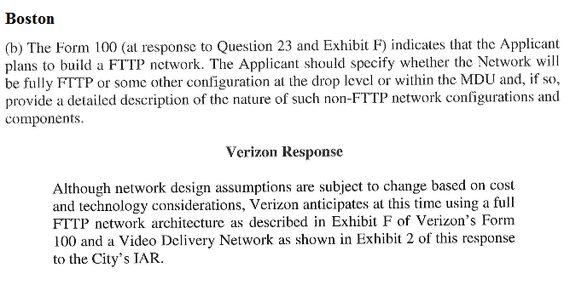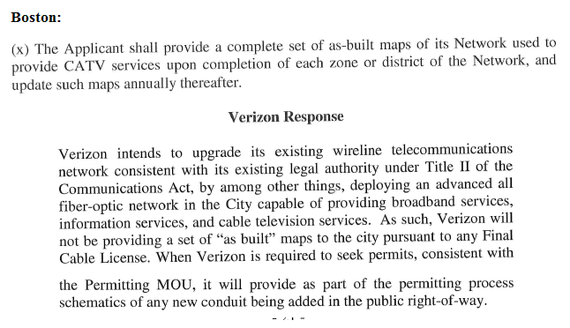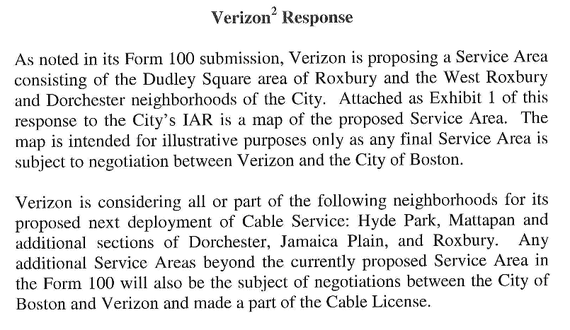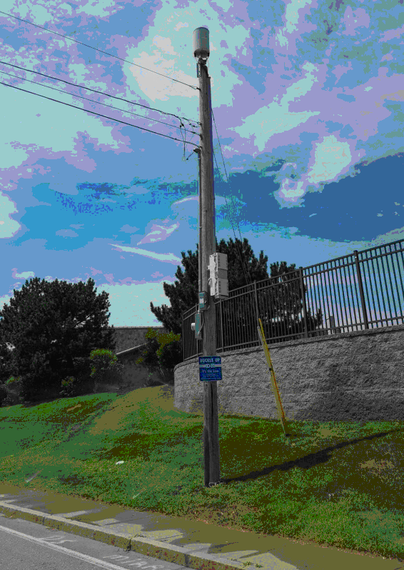Lowell McAdam, Verizon Communications' Chairman and CEO, second quarter, 2016 earnings call, July, 26th, 2016:
"You saw the first fruits of this strategy in April, when we announced our One Fiber strategy for the city of Boston."
In April, 2016, Verizon announced that it was going to spend $300 million over six years to bring FiOS, the company's fiber to the home cable TV and broadband service, to the city of Boston, finally. Boston had been begging the incumbent phone company, Verizon New England, to get off its butt and upgrade the existing copper wires with fiber optics for years - and Verizon just shrugged.
But Verizon never mentioned this 'One Fiber' strategy in April, and it is now becoming known as "Faux FiOS", because it is really a plan to have the wired customers of Massachusetts pay for a bait-and-switch, in plain site, to fund and roll out Verizon's wireless services.
In fact, Boston is the focal point for Verizon's plans - to put in a fiber optic wire , which is really for 'fixed wireless', with lots of antennas, also known as "DAS", -- and to NOT wire the City of Boston with fiber to the home--but focus on 'fiber to the antenna'.
Read our previous articles: More Exposed: Verizon's FiOS-Wireless Bait & Switch in Boston
And while we've written a number of articles already about this, new documents have surfaced, and new statements were made by Verizon senior management that should piss of the entire East Coast of America--Verizon has no plans to wire cities anymore with fiber to the home, and is holding off on doing any other city until this 'test' in Boston is underway.
In short:
- There will be no major deployment of fiber to the home, FTTH, in Boston.
- The company will do the first few areas and then evaluate whether they will go forward.
- The company supplied no maps, no timeline for completion, and it appears will sign no major long term contract to do the entire city.
- The company will lay the fiber as part of 'Title II', telecommunications so that it can get the wireline side phone customers-- including low income families to rural areas, etc., as well as 'broadband data services" (BDS) customers, in the entire state, to pick up the construction for the wires to the cell sites. (BDS are also known as 'special access'; these are the wires used for everything from bank ATM machines to security and alarm systems, etc., to handle the traffic from cell sites or for Wifi hot spots.
- And Verizon's other goals include killing off the unions and competitors.
Worse, this is a model for the rest of Verizon's East Coast state utility holdings; and AT&T is doing similar, if not identical things.
Some background
In 2010, Verizon had announced that it was stopping their FiOS deployments, which had only started around 2005-2006 and it would only finish areas where there was an existing franchise agreement. And, I note that this doesn't include all homes and businesses in the municipality since the franchises that were granted do not require universal service to all, unlike their wireline utility service agreements with the states.
Verizon is the incumbent phone utility for the East Coast, from Massachusetts to Virginia and it left a trail of broken promises - passing less than 50% of locations in their territories - a 'location' being a home or business. But it's worse because Verizon also stopped properly upgrading and maintaining the copper networks as well, causing complaints up and down the East Coast about service quality problems.
And this was all done on purpose as in 2010, Verizon decided to become a 'wireless first' company. It appointed Lowell McAdam to be the CEO, who was then the CEO of Verizon Wireless, (which is actually named "CellCo Partners" and was a joint venture with Vodaphone, the British telecom firm.) And unknown to most, Verizon started diverting the wireline capital expenditures to have the wireline company pay for the build out of wireless towers, which needed to be upgraded with fiber to offer 4G service, throughout the East Coast. Thus, low income families, customers in rural areas, and anyone else with phone or special access service was subsidizing these build outs.
In New York, we tracked how Verizon was granted multiple rate increases on basic phone service and ancillary services for 'massive deployment of fiber optics' and losses, starting in 2006. By 2010, the deployments, as attested to by the New York Attorney General's Office, had been diverted mainly to fund the capEx for the wires to the cell sites; the losses were created based, in part, on this financial cross-subsidy.
So, in April 2016, (and timed to influence the Verizon worker's strike) Verizon announced it was going to spend $300 million in the City of Boston over the next six years to bring fiber optic FiOS to homes.
Boston.comwrote:
"Verizon to build $300M fiber network in Boston"
"Verizon will bring its fiber-optic FiOS network to Boston over the next six years, city and company officials announced..."
Verizon also said that it was not going to do any other cities until the work was underway - i.e., a $130+ billion dollar company is going to spend $50 million a year on Boston --chump change, and was not planning on doing the entire East Coast.
Ironically, as we pointed out, Verizon has announced its intent to purchase Yahoo for $4.8 billion and bought AOL for $4.4 billion last year. We argue that this should never be allowed until the states are upgraded and maintained properly.
There is also an ugly truth - Verizon Massachusetts had made commitments to replace the existing copper networks with fiber optics starting in 1995--yeah, 20+ years ago, and got state laws changed to give the company additional financial 'incentives' to do the work. The company pocketed billions and the state never went back and said - Excuse me--but where's the fiber optic future?--or have the company pay back the billions collected.
- Here is an excerpt from Verizon's original Massachusetts fiber optic plan that was filed with the State-- and was finalized in 1995. Verizon MA was supposed to have 330,000 lines of fiber optics to the home by the year 2000.
- In 1999, a group of us filed a complaint with the State claiming that Verizon (then Bell Atlantic) had overcharged customers by over a billion dollars from 1995-1999, including taking a massive one-time tax deduction to bring 'fiber optic' broadband to the entire state - including the City of Boston.
Exposed: Verizon's Cable Franchise Filings with the City--They don't care about wireline.
Verizon never mentioned this 'One Fiber' strategy to the citizens of Boston, much less the politicians, but now it is clear--the wires being deployed are for wireless, first.
Lowell McAdam pointed out in the latest second quarter investor calls that - I paraphrase: 'Well, wireless is so much cheaper (and more profitable), why bother doing fiber to the home? ("ONT" is an "Outside Network Terminal".)
"From a pure cost perspective, again I think it's a little too early to tell, but what I will tell you is about half of our cost to deploy FiOS is in the home today and the next biggest thing outside the home is the drop. And so our take is that with the router roughly costing the same -- and, remember, we wouldn't have to have an ONT as we think about it today.
"So when we deploy 4G and densify the small cell cantennas (to provide) 5G (service) for very little incremental cost. With the router in the house being probably less than an ONT and router combination today and losing the wiring in the house and losing the drop, we expect there to be a significant cost reduction."
During the writing of the articles a number of documents have surfaced about Verizon's real intentions and their dealings with the city.
Verizon originally filed to offer FiOS by taking years old materials from other filings-- and the city noticed.
The City of Boston wrote:
"(c) Form 100 and Exhibit F: The Fiber-to-the-Premises ("FTTP") Network description appears to be a number of years old and includes information that appears to have been phased out. Please identify any outdated elements in Exhibit F and describe what is in use currently now."
The Boston Faux-FiOS Bait and Switch
First, Verizon is doing three areas first with fiber to the home and then will do a 'wait and see'. These areas were selected because a) Mayor Walsh lives in one and b) the wires are on poles, as opposed to having to do a lot of digging to put them into underground conduit.
Boston asked: If the proposed service area is not the entire municipality, specify the nature of the area (e.g., neighborhood) and explain why the entire municipality will not be served.
Verizon Response - If successful we may 'seek to amend' the license and add other sections.
"The initial service area is for the Dudley Square area of Roxbury and the West Roxbury and Dorchester neighborhoods of the City. If Verizon is granted a cable License for the initial service area and is successful in providing cable service to that area, it may seek to amend its License with the City to add other sections of the City consistent with 207 CMR §3:07."
The Boston Globe, in April, 2016, wrote that this deployment was for the whole city and it was supposed to be wired fiber optic service.
"Verizon is finally ready to offer its high-speed fiber optic service to Boston -- a victory for city officials who have long sought meaningful competition for high-speed Internet and TV service in a city dominated by Comcast Corp.
"Mayor Martin J. Walsh announced the Verizon move Tuesday, a $300 million investment that will roll out in select neighborhoods beginning this summer but will take six years to cover the whole city. Boston has also agreed to speed up permitting for the infrastructure upgrade and to begin the process of licensing Verizon as a cable TV provider."
Next, Verizon was asked to provide maps of the areas. Verizon response is that this is just a network upgrade of the existing copper "Title II" networks, and it doesn't have to provide maps.
Then, Verizon appears to have just lied to the City. The City asks whether there will be any other 'non' fiber to the home -FTTP, components - meaning-- Are you planning on using wireless? Verizon claims it is doing FTTP - when its plan is to substitute the fiber to the home with fixed wireless.

Lawyers could parse this as 'Well, the initial three locations are FTTP so, technically...
Verizon does provide one map where they state that they are 'considering' all or part of other adjacent areas and it shows other areas but the map says it is only 'illustrative' of potential future deployments.

And Verizon continues saying it is considering all or part of some neighborhoods for the next deployments.
In contrast, in our last article, we uncovered that Verizon was more interested in fixed wireless than wireline to the premises. On March, 31, 2016, Verizon Cellco Partners, D/B/A Verizon Wireless, signed a full, 71 page, detailed agreement (and appendixes) to offer wireless services, including DAS, (Distributed Antenna System; small cell, fiber-to-the-antenna)--in the City of Boston.
Getting Rid of those Pesky Competitors and the Unions--Paid for by Low Income Families, Rural Areas, etc.
5G doesn't exist today. Period. It may or may not ever show up, and who knows what it will be able to do as currently it has a distance limitations of 300-500 feet and can't go through walls and has trouble with even lots of trees.
And 4G LTE was supposed to originally do 100 Mbps and the US average is less than 10 Mbps, according to multiple sources.
But that doesn't seem to matter. Verizon's plan is to shut off the residential and business end user wires, keep the 'broadband data services' for private use - for wireless, and in the end, charge more for less.
However, the 'cost savings' and getting rid of the unions are a high priority. If there are no fiber optic wires to be installed or maintained -- i.e., if the fiber to the home and the wiring in the home, etc., or to maintain and provide services over the copper wires (as the majority of wires are still copper) --are all going away--then the union jobs are slashed.
Moreover, getting rid of the wires gets rid of competitors who rely on the wires.
Who's paying for the wireless deployments? And the kicker here is that the fiber optics that will be installed are part of the state utility as "Title II" and are funded via local rates and special access excess profits - i.e., the wireline side of the business has been and will continue to 'cross-subsidize' the wireless expenses.
Interestingly, the reality of what happens in Boston has implications in both Massachusetts as well as the rest of the East Coast.
Fierce Telecom writes:
"As Verizon moves forward with its Boston plans, the call to get FiOS in more cities will grow even louder."Calls to bring FiOS to other Massachusetts towns and cities continues to rise. The mayors of Peabody and Salem sent Verizon a letter pleading with the telco to build out its FTTH service in their towns. With Comcast and satellite services being the only two service options, the city leaders of these North Shore towns say they continue to get requests from residents for an alternative service choice.
"Outside of Massachusetts, 14 mayors on the East Coast called on Verizon previously to expand its FiOS FTTH network into more areas that have limited access to high speed services."
And it appears that what's going on in Boston will make a whole bunch of cities that care about broadband and cable competition have a serious 'wake up' call.
Unfortunately, this is the plan for the entire East Coast of America, and most of the country, as AT&T has similar, if not identical plans.
I'll sum up and add more to this tale in Part 2: Kick the Wireless Cantenna.




